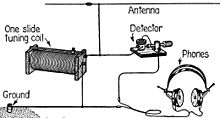Wikijunior:How Things Work/Radio receiver

Radio is a Latin word meaning "around". All around us there are electromagnetic vibrations. When we see things, we are converting light-waves to brain-signals. Light waves are also electromagnetic vibrations, with violet coloured light being the shortest vibration and red light being the slowest vibration we can see. We call the rainbow effect a visible spectrum. Below this is the infra-red spectrum and eventually the radio spectrum. The other electromagnetic radiations, with frequencies above the radio-frequency range, are microwave, infra-red, visible light, ultraviolet, X-rays and gamma rays. To understand the rest of this article you may need to see the page about electricity.

Parts of the radio.
[edit | edit source]A radio receiver first needs an antenna or aerial to detect these electromagnetic waves and turn them into electrical signals. An antenna is usually a rod of metal or a metallic 'ferrite' rod surrounded by coils of wire. Next is a radio frequency (RF) amplifier and usually a low radio-frequency stage called and intermediate amplifier (IF) so that the audio signals can be more easily detected or discriminated from the "carrier" radio-frequency which is discarded. Next comes the audio frequency (AF) and finally the electrical signal is made into sound by a loudspeaker (LS) or "transducer"
Who invented it?
[edit | edit source]Many people were responsible for creating the radio. Some of them are The names of Guglielmo Marconi, Nikola Tesla, Alexander Popov, Sir Oliver Lodge, Reginald Fessenden, Heinrich Hertz, Amos Dolbear, Mahlon Loomis, Nathan Stubblefield and James Clerk Maxwell.
How does it get power?
[edit | edit source]Portable radios get power from batteries. The bigger radios which are not portable are connected to the wall socket.
How does it work?
[edit | edit source]Radio waves are just another form of radiation that are created when a charged electron vibrates with a frequency that lies in the radio frequency (RF) portion of the electromagnetic spectrum. In radio, this acceleration is caused by an alternating current in an antenna.
Radio frequencies occupy the range from a few tens of hertz (cycles per second) to three hundred gigahertz (That is three hundred thousand million (3 x 109Hz). Commercial radio for entertainment and television use only a small part of the radio spectrum. Different channels use different frequencies and therefore do not usually interfere with each other.
About frequencies.
[edit | edit source]Each frequency has a wavelength, so that high frequencies have short-wavelengths, which is why you will hear expressions such as "short-wave amateur band" for "ham radio" or VHF (Very high frequency) for local radio. Long waves tend to travel long distances so in Britain "the long-wave light program" was an entertainment channel broadcasting electromagnetic waves 1500 meters long or 200 thousand cycles per second (200kHz) which was easy to receive anywhere in the British isles. (The service has now been replaced by local VHF transmitters)
The energy of an individual photon of visible or radio frequency is too low to remove an electron from an atom, so radio waves are classified as non-ionizing radiation. X rays, along with nuclear beta, delta and gamma rays can damage living cells in our bodies.
How dangerous is it?
[edit | edit source]The high-powered radio is harmful (can burn us). But fortunately the power of a radio transmitter gets weaker with distance. Hence a high-powered radio is not dangerous at a distance.
What does it do?
[edit | edit source]A Radio sends sound waves though the air and those waves are caught by the receiver.

How does it vary?
[edit | edit source]Radios can be divided into two types.
- Radio designed for you to listen to someone.
- Radio designed for you to listen and to talk to someone.
How has it changed the world?
[edit | edit source]The radio changed the way people communicated all over the globe. What usually took months to communicate from one part of the world to another part of the world could be done in a few minutes.
What idea(s) and/or inventions had to be developed before it could be created?
[edit | edit source]Before a radio could be created, power and antennas had to be developed.
Facts
[edit | edit source]- A commercial transmitter may produce thousands of watts of power, but a receiver not far away will only be able to detect a few millionths of a watt.
- The speed of light and radio waves is 299,792,458 m/s (about 186,282 miles per second). A bit less than 300 million meters per second.